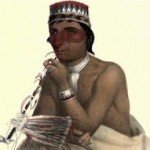
A Chippeway Chief (Chippewa)
Among the most remarkable chiefs we met with at the treaty of La Fond du Lac Superior, in 1826, was Waemboeshkaa, a Chippewa chief. Our attention was attracted more by his style of dress than by any particular part that he bore in the ceremonies of that occasion. He was the only Indian present who seemed to have a right conception of the kingly crown, and to have succeeded in constructing a very successful imitation of that appendage of royalty. It is true, the materials were far more costly; they were a mixture of feathers, glossy, and very beautiful, from the drake’s breast, and of the bills and feathers from the head of the wood pecker. In place of bracelets of metal, his wrists were similarly ornamented, whilst his neck was encircled with horse-hair, colored with vermilion. His pipe was made gay with the same materials, and his pouch had been the object of his special attentions. His blanket was sound, and large, and clean. He was one of the representatives of the Sandy Lake band. He arrived late at the treaty ground; and, on joining the assemblage, appeared conscious that, whatever he might lack in other accomplishments, he was the superior of all present in the ornaments of his person. There did not, however, appear to be any thing deficient in him in other respects; he was thoughtful, respectful, and conducted himself throughout with great propriety.
We might not, perhaps, have singled him out on account of his dress, if the seven hundred Indians, of both sexes, and of all ages, by whom he was surrounded, had not formed so disadvantageous a contrast, They were amongst the worst clad, and most wretched body of Indians we ever met with. Our remarks, made at the time, are now before us; we give the following extract: “Never before had we witnessed such a display, nor such an exhibition of nakedness and wretchedness, nor such varieties of both. From the infant, tied to its cradle, and to the back of its mother, to the Big Buffalo; from the little fellow, with a dress made of raccoon skins, himself not much above the size of that animal, and looking, except his face, for all the world like one of them on its hinder feet, to Waemboeshkaa, one of the Sandy Lake chiefs, dressed like King Saul.” So we denominated this chief at the time; and he bore a very remarkable likeness to that personage, crown and all, as we have seen him sketched by those who have indulged their fancy in presenting to the world their imaginings of this renowned personage.
Whatever of humiliation might have been produced by those who were lowest in the scale of want, was relieved by suitable presents, before we left the treaty ground. Waemboeshkaa, it is true, received his due proportion, and maintained, therefore, his superiority in personal wealth and endowments.
We parted from this chief at the conclusion of the treaty, and have heard nothing of him since; nor did we learn, at the time, that he had ever particularly Distinguished himself, (not even by much smoking, for all Indians are inveterate smokers,) but inferred that, either by descent, or exploits in war, he was high in the confidence of his band, or that otherwise he would not have been deputed to attend the treaty in the capacity of chief.
